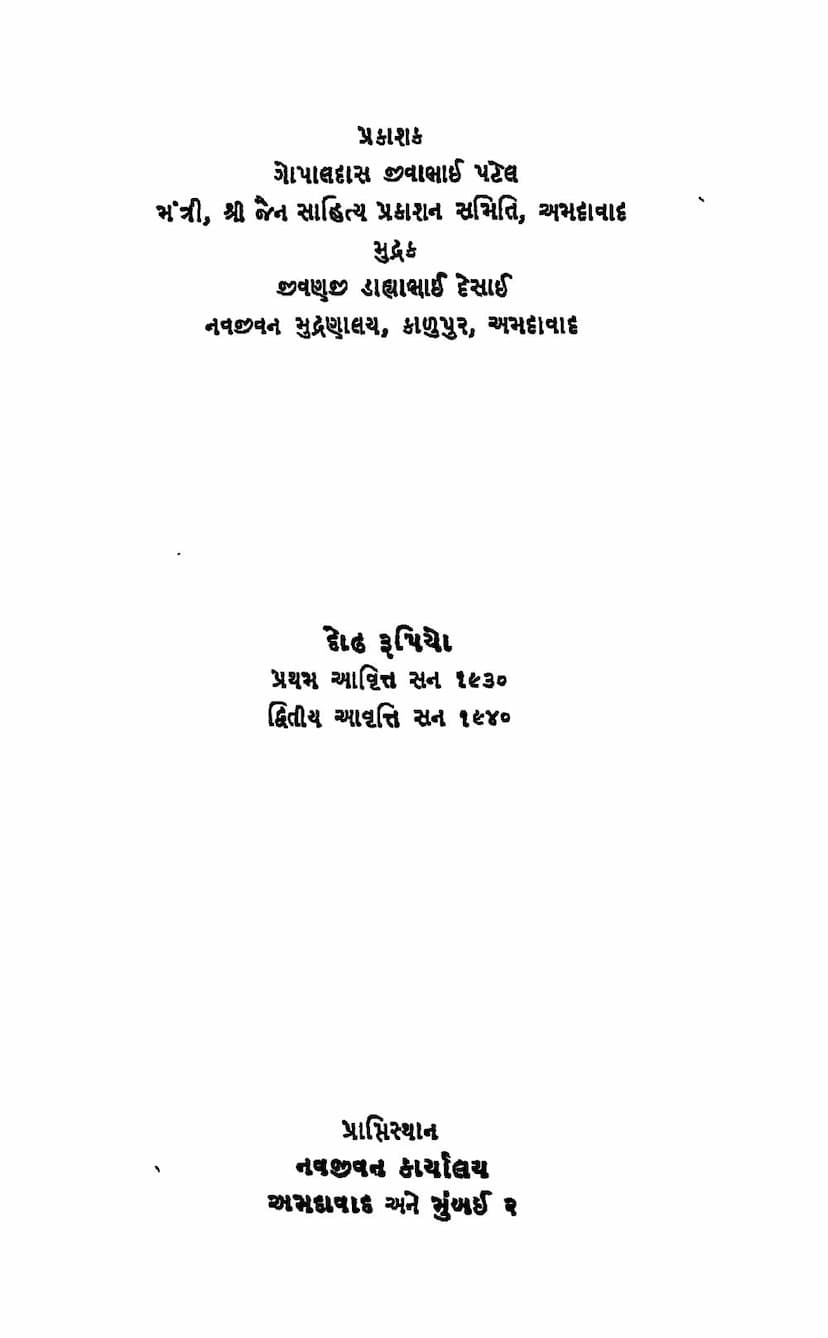Tattvarthadhigam Sutrani
Added to library: September 2, 2025

Summary
This is a comprehensive summary of the Jain text "Tattvarthadhigam Sutrani" by Sukhlal Sanghavi, based on the provided pages and catalog link.
Book Title: Tattvarthadhigam Sutrani Author: Sukhlal Sanghavi Publisher: Jain Sahitya Prakashan Mandir
Overall Summary:
The provided text offers a detailed introduction and commentary on the Tattvarthadhigama Sutras, a foundational scripture in Jainism. The work, compiled and edited by the esteemed scholar Pandit Sukhlal Sanghavi, aims to make the profound principles of Jain philosophy and practice accessible to a wider audience. The text is structured to provide a thorough understanding of the Tattvarthas (Realities or Principles) as expounded in the Sutras, delving into their historical context, authorship, philosophical nuances, and comparative aspects with other Indian philosophical schools.
Key Aspects and Themes:
-
Authorship and Historical Context: The text extensively discusses the authorship of the Tattvarthasutra, attributing it to Umaswati. It explores the various traditions and theories surrounding his identity, lineage (Vidyavansh), and time period, referencing historical evidence from inscriptions and texts. It also touches upon the evolving nature of philosophical discourse and how the Umaswati's original compilation was further developed by commentators.
-
Structure and Content of Tattvarthasutra: The summary highlights that the Tattvarthasutra is divided into ten chapters (adhyayas) covering a wide range of Jain philosophy and practice. The author meticulously breaks down the content of each chapter, explaining the key concepts and principles discussed:
- Chapter 1: Focuses on the path to liberation (Moksha Marga) comprising Right Faith (Samyak Darshan), Right Knowledge (Samyak Gyana), and Right Conduct (Samyak Charitra). It elaborates on the nature of knowledge (Mati, Shruta, Avadhi, Manahparyaya, Kevala) and the means of acquiring it. It also introduces the concept of Nayas (viewpoints) and their importance in understanding reality.
- Chapter 2: Delves into the Jiva (soul) and Ajiva (non-soul) categories, detailing the five types of souls and their states, the concept of vitalities (Upyoga), and the causes and types of bondage. It discusses the various bodies (Sharira) and the soul's relation to them.
- Chapters 3 & 4: Describe the nature of the universe (Loka), its divisions (Urdhva, Adho, Madhya Loka), the various realms within them, particularly focusing on the Naraka (hellish) beings and Devas (celestial beings), their lifespans, and classifications. It touches upon the cosmological aspects of Jainism.
- Chapter 5: Expounds on the Ajiva categories, detailing Dharma (medium of motion), Adharma (medium of rest), Akasha (space), Pudgala (matter), and Kala (time). It explains their unique qualities and functions. Pudgala's pervasive nature and its various transformations are discussed.
- Chapters 6, 7 & 8: Focus on the path of conduct (Charitra), detailing the categories of vows (Vrata), their classifications (Maha Vrata, Anu Vrata), the supplementary disciplines (Shiksha Vrata), and the cardinal sins (Himsa, Kasaya, etc.) that obstruct spiritual progress. It explains the concept of Asrava (influx of karma), Samvara (cessation of influx), Nirjara (shedding of karma), and Bandha (bondage). It details the causes of bondage (Mithyatva, Avirati, Pramada, Kasaya, Yoga) and the types of karma (Prakriti, Sthiti, Anubhava, Pradesha).
- Chapter 9: Explains the path of conduct further, detailing the disciplines like Gupti (restraint), Samiti (vigilance), Dharma (virtues), Anupreksha (contemplations), Parishaha (endurance), and Charitra (conduct) itself. It elaborates on the concept of Tapas (austerities) and the stages of spiritual progress leading to liberation.
- Chapter 10: Focuses on Moksha (liberation) and the nature of the Siddha (liberated soul). It outlines the causes of omniscience (Kevala Gyana) and the ultimate state of liberation, emphasizing the role of the destruction of karma.
-
Philosophical Depth and Comparative Analysis: The text is highly praised for its in-depth analysis and comparative study of Jain doctrines with other Indian philosophical schools like Vedanta, Samkhya, Yoga, Vaisheshika, Nyaya, and Buddhism. Sukhlal Sanghavi's meticulous research highlights the unique aspects of Jainism while also identifying potential influences and parallels. The author emphasizes the importance of the nine Tattvas (realities) as the core of Jain epistemology and practice.
-
Linguistic and Stylistic Approach: Pandit Sukhlal Sanghavi is recognized for his mastery of Sanskrit and Prakrit languages. He adeptly weaves together the complex philosophical concepts from the original Sutras, their commentaries (Bhashya, Sarvarthasiddhi, Rajavartika, Lokavartika), and various Agamas into a coherent and accessible Gujarati narrative. The text showcases his profound scholarly understanding and his dedication to making the tradition accessible.
-
The Role of Commentaries: The summary reveals the importance of various commentaries on the Tattvarthasutra, such as the Bhashya, Sarvarthasiddhi, and Rajavartika, in shaping the understanding and interpretation of the Sutras. The author also engages with the historical debates between Digambara and Shvetambara traditions regarding Umaswati and the Tattvarthasutra's commentary.
-
Pedagogical Suggestions: Towards the end, the author provides valuable suggestions for teachers and students on how to effectively study the Tattvarthasutra, advocating for a comparative approach that considers different commentaries and historical perspectives. He stresses the importance of moving beyond sectarian views to grasp the true essence of the teachings.
In essence, the "Tattvarthadhigam Sutrani" by Sukhlal Sanghavi serves as a monumental scholarly work that not only elucidates the Tattvarthasutra but also provides a comprehensive framework for understanding Jain philosophy, its historical development, and its unique place within the broader landscape of Indian thought.